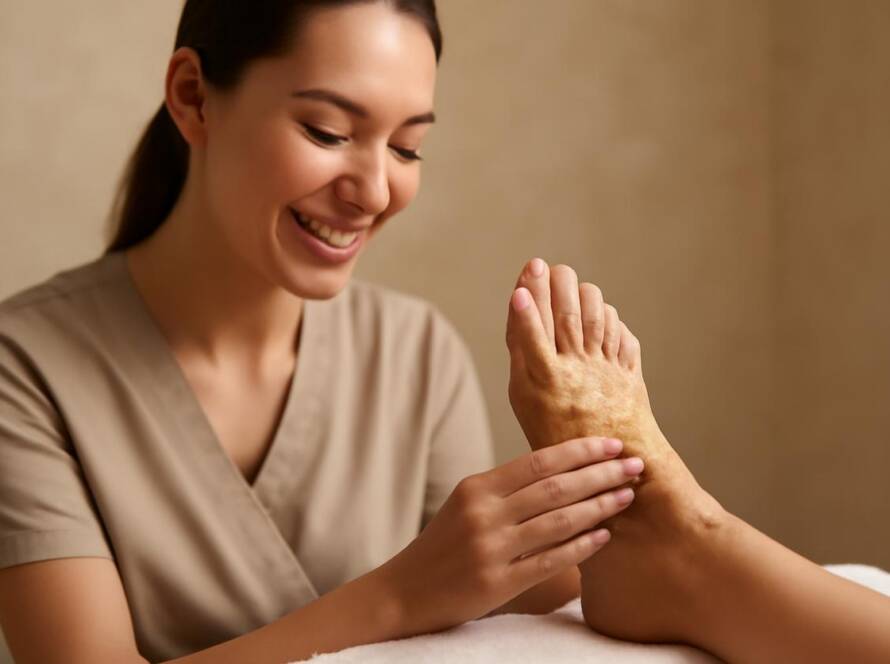Why a Pedicure is More Than Just Polish: The Importance of Foot Care
Often, we think of a pedicure as a cosmetic treat—a way to get our toes ready for sandal season. While beautifully painted nails are a wonderful result, the true value of a regular pedicure lies in its contribution to your overall health, comfort, and mobility. Your feet are your body’s foundation, carrying you through thousands of steps each day. Neglecting them can lead to discomfort, pain, and even long-term problems that affect your posture and ability to move freely.
A proper, health-focused pedicure is a preventative practice. It helps remove dead skin, manage calluses that can cause painful pressure points, and prevent ingrown toenails. By regularly inspecting your feet during an at-home pedicure, you can catch potential issues like fungal infections or blisters early on. This guide will empower you to perform a safe, effective, and relaxing at-home pedicure that prioritizes the health of your feet.
Your At-Home Pedicure Toolkit: Essential Tools and Products
You don’t need a professional salon setup to give yourself a fantastic pedicure. Investing in a few quality, non-branded tools will set you up for success. Think of these as your core foot care essentials.
Essential Pedicure Tools
- Foot Basin: A simple tub or basin large enough to comfortably soak both feet.
- Nail Clippers: Choose a straight-edged clipper designed for toenails to help prevent ingrown nails.
- Nail File: An emery board or glass nail file for smoothing and shaping nail edges.
- Nail Buffer: A multi-sided block to smooth ridges and create a natural shine.
- Pumice Stone or Foot File: For gently exfoliating calluses and rough patches. Avoid harsh metal graters.
- Cuticle Pusher: A wooden or rubber-tipped stick to gently push back cuticles. Never cut them at home.
- Soft Towel: A clean, fluffy towel dedicated to your foot care routine.
Basic Pedicure Products
- Gentle Soap or Foot Soak: To cleanse your feet and soften the skin.
- Foot Scrub: A simple sugar or salt scrub for exfoliation.
- Rich Moisturizer: A thick cream or lotion formulated for dry skin (a body butter works well).
- Cuticle Oil or Natural Oil: Such as jojoba, almond, or olive oil to nourish the nail beds.
Natural and Gentle Alternatives for Sensitive Skin
If you have sensitive skin or prefer a more natural approach, your kitchen pantry holds many effective ingredients for a gentle pedicure. These simple swaps can reduce the risk of irritation while providing excellent results.
| Standard Product | Gentle, Natural Alternative | Benefit |
|---|---|---|
| Commercial Foot Soak | Epsom salts and a few drops of lavender essential oil | Soothes tired muscles and softens skin without harsh detergents. |
| Store-Bought Exfoliating Scrub | Brown sugar mixed with olive or coconut oil | Provides gentle, effective exfoliation and deep moisture. |
| Cuticle Remover Cream | A drop of jojoba or olive oil | Softens cuticles naturally for easy, gentle push-back. |
| Heavy Foot Cream | Shea butter or coconut oil | Offers intense, single-ingredient hydration without added fragrances or preservatives. |
The Ultimate At-Home Pedicure: A Step-by-Step Guide
Ready to give your feet the attention they deserve? Follow these podiatrist-informed steps for a safe and restorative at-home pedicure. Set aside about 45-60 minutes in a comfortable space where you can relax.
Step 1: Preparing Your Feet with a Cleansing Soak
The first step in any good pedicure is a warm, cleansing soak. This not only cleans your feet but also softens skin, nails, and cuticles, making them easier to manage. Fill your foot basin with warm (not hot) water and add a mild soap or your chosen natural alternative, like Epsom salts. Soak your feet for 10 to 15 minutes. Soaking for too long can over-hydrate the skin, making it more prone to damage.
Step 2: Exfoliation Techniques for Silky Smooth Skin
After soaking and gently patting your feet dry, it’s time to exfoliate. Exfoliation removes the buildup of dead skin cells, revealing softer skin underneath and allowing moisturizer to penetrate more effectively.
- For most skin types: Apply a foot scrub in gentle, circular motions, concentrating on the heels, balls of your feet, and any other rough areas. Rinse thoroughly.
- For sensitive skin: Use a softer scrub, like an oatmeal and honey mixture, and apply with very light pressure.
Step 3: Safe Nail Trimming, Shaping, and Cuticle Care
Proper nail care is crucial for preventing painful issues like ingrown toenails. Always approach this step with care and precision.
- Trimming: Use a clean, sharp toenail clipper. Cut nails straight across, ensuring you don’t round the corners or cut them too short. The top of the nail should be roughly even with the tip of your toe.
- Shaping: Use a nail file to gently smooth any sharp edges left from clipping. File in one direction to prevent splitting.
- Cuticle Care: Apply a drop of cuticle oil to the base of each toenail. Use a wooden or rubber-tipped cuticle pusher to gently push back the softened skin. Never cut your cuticles, as they serve as a barrier against bacteria.
Step 4: Gentle Callus Reduction and Prevention
Calluses are areas of thickened skin that form in response to pressure and friction. While they are protective, excessive buildup can become uncomfortable. The key to callus care is gentle, consistent reduction, not aggressive removal.
Using a pumice stone or gentle foot file on damp skin, rub the callused area in a circular motion with light to medium pressure. The goal is to remove the top layers of dead skin, not the entire callus at once. Aggressive filing can cause soreness and may even make the callus grow back thicker. Regular moisturizing is the best prevention strategy.
Step 5: Deep Moisturization and Nourishing Oils
Hydration is arguably the most important step for maintaining soft, healthy feet. After you have finished filing and exfoliating, apply a generous amount of a thick, rich moisturizer all over your feet, paying special attention to your heels. Massage the cream in until it is fully absorbed. For an extra-nourishing treatment, apply the cream at night and wear a pair of cotton socks to bed to lock in the moisture.
Step 6: Massage, Circulation, and Dry Brushing
A simple foot massage can relieve tension, improve circulation, and make your pedicure feel truly luxurious. Use your thumbs to apply firm pressure to your arches and the balls of your feet. Gently pull and rotate each toe. Another beneficial practice is dry brushing. Before your soak, use a natural bristle brush on dry feet, brushing in long, upward strokes from your toes toward your heart to stimulate blood flow.
Step 7: Aftercare for Long-Lasting Results
The care you take after your pedicure is just as important as the pedicure itself. Ensure your feet are completely dry, especially between the toes, to prevent fungal growth. If you are applying polish, allow it to dry completely before putting on socks or shoes. On a daily basis, moisturize your feet and wear comfortable, well-fitting footwear to protect your hard work.
Safety First: Ingredients to Avoid and Key Considerations
A safe at-home pedicure is a healthy one. Foot care strategies for 2025 and beyond emphasize gentle, non-toxic ingredients and safe practices. Be mindful of what you put on your skin and the tools you use.
- Avoid harsh chemical peels: Products that promise to peel off layers of skin can be too aggressive, causing burns and irritation.
- Say no to razors: Never use a razor or blade to remove calluses. This practice, often called “foot shaving,” is dangerous and can lead to serious cuts and infections.
- Check for skin-safe ingredients: Avoid products with high concentrations of alcohol, artificial fragrances, and parabens if you have sensitive skin.
- Tool sanitation: Always clean your tools with soap and water and let them air dry after each pedicure. Disinfect them with rubbing alcohol periodically.
Your 4-Week Pedicure Maintenance Calendar
Consistency is key to long-term foot health. A full pedicure isn’t necessary every week. Follow this simple schedule to keep your feet in top shape.
| Week | Main Task | Daily Habit |
|---|---|---|
| Week 1 | Perform a full at-home pedicure (soak, exfoliate, trim, moisturize). | Moisturize feet before bed. |
| Week 2 | Light maintenance: Gently file any rough spots with a pumice stone and apply a deep moisturizing treatment overnight. | Moisturize feet before bed. |
| Week 3 | Nail check: File nails to maintain shape and push back cuticles after your shower. Re-apply moisturizer. | Moisturize feet before bed. |
| Week 4 | Light maintenance: Gentle exfoliation with a scrub and deep moisturization. Prepare for your next full pedicure. | Moisturize feet before bed. |
Troubleshooting Common Foot Issues at Home
Even with great care, you might encounter a few common issues. Here’s how to handle them.
- Extremely Dry, Cracked Heels: Increase your moisturizing routine. Use a thick ointment or balm containing urea or lactic acid and wear cotton socks to bed.
- Potential Ingrown Nail: If you notice redness or slight tenderness at the corner of a nail, ensure you are not cutting the nail too short or rounding the edges. A small soak in warm salt water can help. If it becomes painful, swollen, or shows signs of infection, see a professional.
- Blisters: Avoid popping blisters. Clean the area, apply an antibiotic ointment, and cover it with a bandage. Wear shoes that don’t rub on the affected spot.
When to See a Specialist: A Podiatrist’s Advice
An at-home pedicure is excellent for maintenance, but it is not a substitute for medical care. You should consult a podiatrist or other healthcare professional if you experience any of the following:
- Signs of a fungal infection (thick, yellow, or brittle nails).
- Painful or infected ingrown toenails.
- Warts or other persistent skin lesions.
- Pain that does not go away with rest.
- Any foot-related concerns if you have diabetes, poor circulation, or a compromised immune system. The American Podiatric Medical Association provides resources for finding qualified professionals.
FAQ: Your Quick Pedicure Questions Answered
How often should I do a full pedicure at home?
A full pedicure is recommended every 4 to 6 weeks, with weekly maintenance like moisturizing and light filing in between.
Is it better to file my nails wet or dry?
For toenails, it’s best to file them when they are dry to prevent peeling and splitting. The nail plate is weaker when wet.
Can I use body lotion on my feet?
Yes, you can. However, the skin on your feet, especially your heels, is much thicker, so a specialized foot cream or a very rich body butter will often be more effective.
Further Reading and Trusted Resources
For more evidence-based information on foot health and care, we recommend these trusted sources:
- Mayo Clinic: Offers practical advice on foot care basics, from choosing the right shoes to dealing with common ailments.
- National Institutes of Health (NIH): Provides in-depth research and health information on a wide range of topics, including skin and nail health.
- American Podiatric Medical Association (APMA): The leading resource for foot and ankle health, with expert tips and a directory of certified podiatrists.



